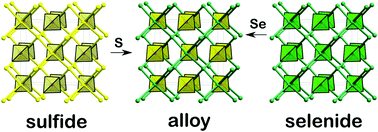Effect of anion substitution on the structural and transport properties of argyrodites Cu7PSe6−xSx†
Abstract
Inspired by the good performance of argyrodites as ion conducting thermoelectrics and as solid electrolytes we investigated the effect of isovalent S2− substitution for Se2− in Cu7PSe6. At room temperature Cu7PSe6 crystallizes in the primitive cubic β-polymorph of the argyrodite structure and transforms to the face-centered high-temperature (HT) γ-modification above 320 K. The transition for the homologous Cu7PS6 occurs at 510 K. Promising thermoelectric and ion conducting properties are observed only in the HT modification, where the cations are mobile. Using Rietveld refinements against X-ray diffraction data the effect of isovalent S2− substitution for Se2− on the structural and transport properties in Cu7PSe6−xSx was analyzed. While a step-wise incorporation of S2− showed typical behavior for a homogeneous solid solution series, the analysis of the diffraction data gave clear evidence of anion ordering due to site preference of the sulfide ions, which can be rationalized using Pearson's HSAB concept. This leads to a stabilization of the HT structure even at lower temperatures. This selective control enables new strategies for the design of argyrodite materials, as isovalent substitution not only allows an engineering of properties, but also permits the stabilization of the polymorph with the most promising properties.



 Please wait while we load your content...
Please wait while we load your content...